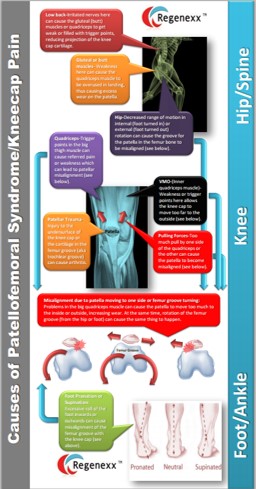Knee Cap Pain: New MRI Research Shows the Hip Bone is Connected to the Knee Bone…
What causes knee cap pain? A while back, I published an infographic that looked at the causes of patellofemoral syndrome (“PFS”, see above-click on it to see a bigger version). PFS happens when the knee cap is not tracking accurately in its groove and the extra friction between the two is leading to cartilage injury and arthritis. One of the factors listed that could cause the problem was the position of the femur (which makes up the groove-see above). Now a new study published this month confirms this idea. The research effort used cine MRI (a movie made of MRI images) to look at the relative positions of the knee cap and its groove as 15 female patellofemoral patients and 15 normal control patients performed deep knee bends. The results? All women had their knee caps track too much to the outside, but interestingly, they also had a problem with their femur bones (the groove) rotating too much to the inside. The upshot? As shown above, the position of the knee cap is important, but so is what happens at the hip (presumably weak hip muscles caused loss of control of the femur in a deep squat position). So treating knee cap pain related issues are as much about fixing what’s going on at the hip as they are about what’s going on in the knee!

If you have questions or comments about this blog post, please email us at [email protected]
NOTE: This blog post provides general information to help the reader better understand regenerative medicine, musculoskeletal health, and related subjects. All content provided in this blog, website, or any linked materials, including text, graphics, images, patient profiles, outcomes, and information, are not intended and should not be considered or used as a substitute for medical advice, diagnosis, or treatment. Please always consult with a professional and certified healthcare provider to discuss if a treatment is right for you.

